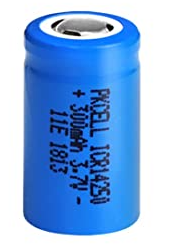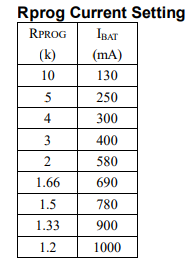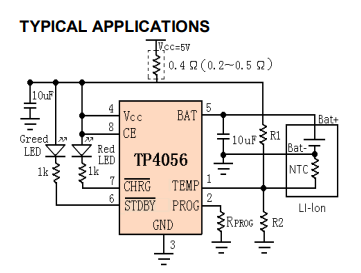Charge Current of a Battery Management System

In this article, we explain a very important part of a battery management system, which is the charge current that it feeds to a battery.
This ultimately is what we think of when we think of a battery charger.
It's current that charges a battery.
The charge current is the current that allows the battery to recharge.
The charge current is very important because the amount of current determines how long the battery takes to recharge. A higher current equates to a faster charge time, while a lower current equates to a longer charge time.
As an example, let's take the TP4056 1A standalone linear li-on battery charger with thermal regulation.
The datasheet for this IC can be found at the following link: TP4056 1A Standalone Linear Lithium Ion Battery Charger
So with this IC, the charge current is programmable via the resistor that is chosen.
Obviously, according to ohms's law, a smaller resistor equals greater curren, while a larger resistor equals less current. Through the resistor that we choose, we can set the charge current for a battery management system.
Going through the datasheet, we can see a table called Rprog Current Setting, which is shown below.

Just to give you some perspective, let's look at the schematic diagram for a typical application for the TP4056 chip. This is shown below.

If you look at pin 2, the PROG pin, this is where you place the resistor that determines the charge current.
And according to the table, a 10KΩ resistor creates a 130mA charge current, while at the other end of the spectrum, a 1.2KΩ resistor creates a 1000mA, or 1A, charge current.
This battery management system IC is rated for 1A. So this what would be the limit. If you want a higher charge current, you would have to use a battery management system IC that is rated for a higher current.
So knowing this and knowing the battery capacity that a device has, we can calculate approximately how long it would take to charge a given device with a given battery management system.
The formula is very basic being a simple linear division equation, Battery capacity of device/Charge current.
So if a certain electronic device has a battery capacity of 2000mAh and the charge current is 1000mA (or 1A), it would take approximately 2 hours to charge the device (2000mA/1000mA= 2).
Let's look at a real-world example in the iphone.
According to Apple's own website, the 20W USB-C power adapter provides 9VC/2.2A of power to charge the device. So the charge current is 2.2A when using this device, which is very commonplace nowadays.
Now let's look at the specific iphones.
The iPhone 15 Pro has a 3,274mAh battery. Therefore, with the 20W USB-C power adapter it would take 1.48 hours to charge (3274/2200 = 1.48).
The iPhone 15 Plus has a 4,383mAh battery. Therefore, with the 20W USB-C power adapter it would take 1.99 hours or approximately 2 hours to charge (4383/2200 = 1.99).
The iPhone 15 has a 3,349mAh battery. Therefore, with the 20W USB-C power adapter it would take 1.52 hours to charge (3349/2200 = 1.52).
So you can see that charging with all models of iPhone 15 with the 20W USB-C power adapter, charging takes less than 2 hours.
This is the type of fast charging that people have come to expect.
Fast charging is becoming more and more the industry standard where charging of electronic devices take a mere hours instead of half a day or days to charge.
Therefore, when you are designing a battery management system for an electronic device, you must take into account the charge current and how long it will take to charge a particular device that you are using the system for.
Since users have come to expect an electronic device to charge in just a few hours, you must ensure that your battery management system is up to par with industry standards.
So if you were to use the TP4056 chip, we know that the maximum charge current is 1A, which is less than half the current of an iphone wall charger. And this is the most current it can give.
So if we are charging a device with a battery capacity of 4000mAh with 1A, it would take 4 hours to charge.
If you were to use the lowest current recommended by the datasheet of 130mA, which uses a 10KΩ resistor, charging the same 4000mAh device would take 30.76 to charge the device, which in today's standard would be unacceptable.
This is why charge current is such an important consideration when designing a battery management system.
Related Resources
